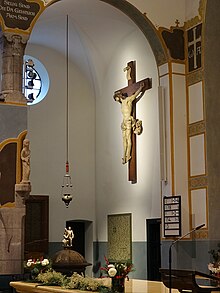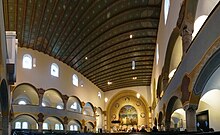Church of the Redeemer (Munich)
The Evangelical Lutheran Church of the Redeemer ( ) is the oldest Evangelical parish church in Schwabing . It is at Ungererstraße 15. It was built from 1899–1901 according to plans by Theodor Fischer . The architectural style is a mixture of historicism and art nouveau .
history
The constant immigration of Evangelicals to Schwabing in the 19th century (including a disproportionately large number of intellectuals and socially better off) soon made the prayer room , which had been in Haimhauser Strasse 1 since 1893, too small. For this reason, Theodor Fischer created the first concrete designs for the sixth Evangelical Lutheran parish church in Munich on behalf of a church building association founded in 1897 based on sketches from the previous year. He oriented himself towards St. Anna im Lehel , which came from Gabriel von Seidl . After the purchase of the building plot, the building preparation could begin in 1899, on April 29, 1900 (Sunday Misericordias Domini ) the foundation stone was laid at the place of the future pulpit. The company Alois Ansprenger was responsible for the execution. Most of the sculpting work was carried out by Ernst Neumeister , while Josef Hellich did the decorative painting. The glass paintings were made by the Bamberg glass painting company August Schmidt. Georg Lindner was in charge of construction. The construction cost was around 200,000 marks. After an organ from Georg Friedrich Steinmeyer's workshop had been installed with two manuals , the church was consecrated on October 6, 1901 by senior consistorial councilor D. Prinzing. The cycle of frescoes planned by Wilhelm Voltz, however, had not yet been completed at the time of the inauguration. Linda Kögel created the painting in the apse in 1904 and Hermann Lang the outer relief in 1906. In 1907 the Erlöserkirche, which until then had been part of the parish of St. Markus in Maxvorstadt as a branch church , was built as an independent parish . The first general renovation took place in 1938. The Erlöserkirche is one of the first churches in Bavaria in which the arrangement of the pulpit, altar, baptismal font and organ enables the faithful to experience the word and the sacrament closely.
The church was hardly damaged in the Second World War . It was repaired as early as 1945 and was renovated in 1947. The last general renovation took place in 1976, largely preserving the concept of Theodor Fischer.
Organs
There are two large organs and a chest organ in the Church of the Redeemer .
Steinmeyer organ
The south pore organ was built in 1901 by the organ building company GF Steinmeyer & Co. (Oettingen) as a two-manual instrument with 21 stops and pneumatic action . In 1938 Albert Moser (Munich) added a swell mechanism to this instrument and equipped it with electric action; Steinmeyer's sound image was largely retained. Today the instrument has 49 registers.
|
|
|
|
|||||||||||||||||||||||||||||||||||||||||||||||||||||||||||||||||||||||||||||||||||||||||||||||||||||||||||||||||||||||||||||||||||||||||||||||||||||||||||
- Coupling : II / I, III / I, III / II, I / P, II / P, III / P
- Playing aids : Tutti step, three free combinations , crescendo roller .
Rieger organ
The organ on the west gallery was built in 1990 by Rieger Orgelbau . The instrument has 43 stops on three manuals and a pedal. In order to fit it harmoniously into the church, it was placed in the niche behind the gallery. The gaming table is free.
|
|
|
|
|||||||||||||||||||||||||||||||||||||||||||||||||||||||||||||||||||||||||||||||||||||||||||||||||||||||||||||||||||||||||||||||||||||||||||||||||||
- Coupling : I / II, III / II, III / I, I / P, II / P, III / P
Bells
The original bell, cast by Franz Schilling from Apolda , rang every Sunday with the tone sequence b 0 –c 1 –d 1 –f 1 –g 1 . In the last years of the Second World War , four bells had to be delivered as war victims. Since 1950 the church has had a four-part bronze bell with the disposition c 1 –es 1 –f 1 –g 1 , whereby the large c 1 bell ( Reger bell) is still from the historical inventory. Every Saturday at 3 p.m., the four-part bells ring for five minutes with the ringing of Sunday.
Location and program
The Church of the Redeemer is in a prominent position: it closes the Münchner Freiheit to the north and at the same time forms the visual end of Leopoldstrasse , which is the extension of Ludwigstrasse . Ludwigstrasse is home to the Catholic Parish and University Church of St. Ludwig , to which Theodor Fischer wanted to set a counterpart with the Church of the Redeemer.
With this, Fischer wanted to meet his first requirement for a church: it should be a Bavarian church . In addition, it should also become a Protestant preaching church and home for the congregation . In order to meet the requirements of a preaching church , he chose the classic basilica shape. To become home for the community, Theodor Fischer used his own style between historicism and art nouveau . At the same time he tried to transition from urban to suburban development with loosened building dimensions in the style of rural village architecture, which corresponded to the situation at the time.
Remarkable equipment elements

- Art Nouveau font (Theodor Fischer, designed in 1904, executed in 1938)
- Capitals with influences from Art Nouveau (Theodor Fischer, 1901)
- Apse fresco The life of the community under the protection of the exalted (Linda Kögel, 1904);
literature
- Lothar Altmann: Evang.-Luth. Church of the Redeemer Munich-Schwabing . Kunstverlag J. Fink, Lindenberg i. General 2018, ISBN 978-3-95976-179-6 .
- Klaus Gallas : Munich. From the Guelph foundation of Henry the Lion to the present: art, culture, history . DuMont, Cologne 1979, ISBN 3-7701-1094-3 (DuMont documents: DuMont art travel guide).
- Armin Rudi Kitzmann: The open gate. From the history of the Protestants in Munich . Claudius, Munich 1990, ISBN 3-532-62094-4 .
- Klaus Koch (Ed.): Church of the Redeemer Munich-Schwabing 1901–1976. A piece of Munich freedom. A documentation . Self-published by Evang.-Luth. Church parish Erlöserkirche, Munich 1976.
- S. Langenberger: The Redeemer Church in Munich . In: Süddeutsche Bauhütte . tape 18 , no. 8 , 1907, pp. o. p .
Web links
- Internet presence of the Evangelical Luth. Parish Church of the Redeemer
- photos
- Sheet 98, design drawing by Fischer, (online) in the Architekturmuseum der Technische Universität Berlin , sheet 99, design drawing by Fischer, (online) in the Architekturmuseum der Technische Universität Berlin
- Plenum of the Church of the Redeemer
Individual evidence
- ↑ Information on the Steinmeyer organ on the municipality's website (as of March 4, 2020)
- ↑ Information on the Rieger organ on the municipality's website (as of March 4, 2020)
Coordinates: 48 ° 9 ′ 52.8 " N , 11 ° 35 ′ 16.7" E





